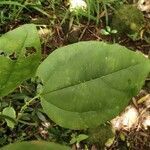Woody vines. Young branches striate, puberulent to subglabrous. Petiole 1-3(-5) cm, whitish tomentose or pubescent; leaf blade variable in shape, linear-lanceolate to broadly ovate, narrowly elliptic to rotund, oblanceolate to obcordate, sometimes 3(-5)-lobed, 3-8(-10) cm, variable in width, papery to thinly leathery, both surfaces puberulent to glabrous, base rounded to truncate, occasionally broadly cuneate or shallowly cordate, margin entire, apex acute or obtuse, with a finely mucronate acumen, sometimes slightly emarginate or 2-lobed, palmately 3(or 5)-veined, basal pair of veins usually obscure beyond middle of leaf blade, slightly raised abaxially. Inflorescences axillary, cymose, few flowered, or many flowered arranged in a narrow terminal or axillary thyrse, up to 10 cm or longer, puberulent. Male flowers: bracteoles 1 or 2, ca. 0.5 mm, closely adnate to sepals, puberulent; sepals 6, outer whorl ovate or elliptic-ovate, 1-1.8 mm, inner whorl broadly elliptic to rotund, sometimes broadly obovate, up to 2.5 mm or slightly longer; petals 6, 1-2 mm, with sides shortly above base folded inward around opposite filament, apex divided into 2 acuminate or acute lobes; stamens 6, shorter than petals. Female flowers: sepals and petals as in male flower; staminodes 6, minute; carpels 6, glabrous. Drupes rotund, red to reddish purple, usually 7-8 mm in diam.; endocarp bony, 5-6 mm in diam., abaxially ornamented with branched ridges.
A woody vine. It grows 4 m long. It loses its leaves during the year. The leaves vary in shape. They are oval and 3-8 cm long. The fruit are black.


